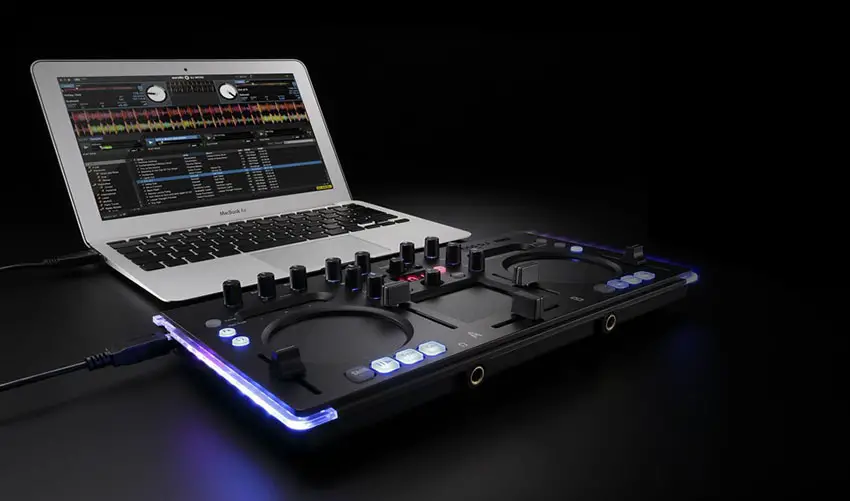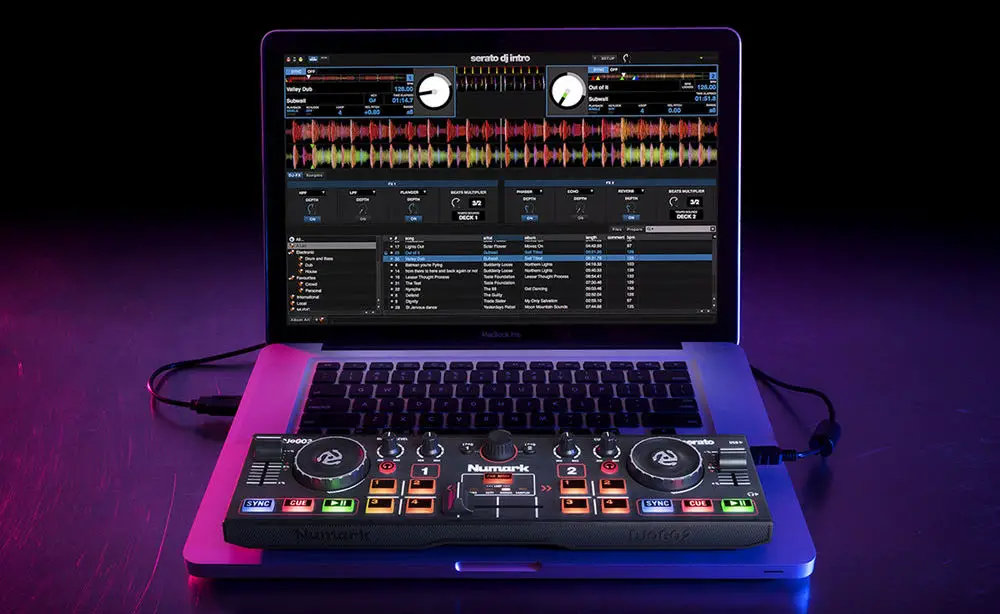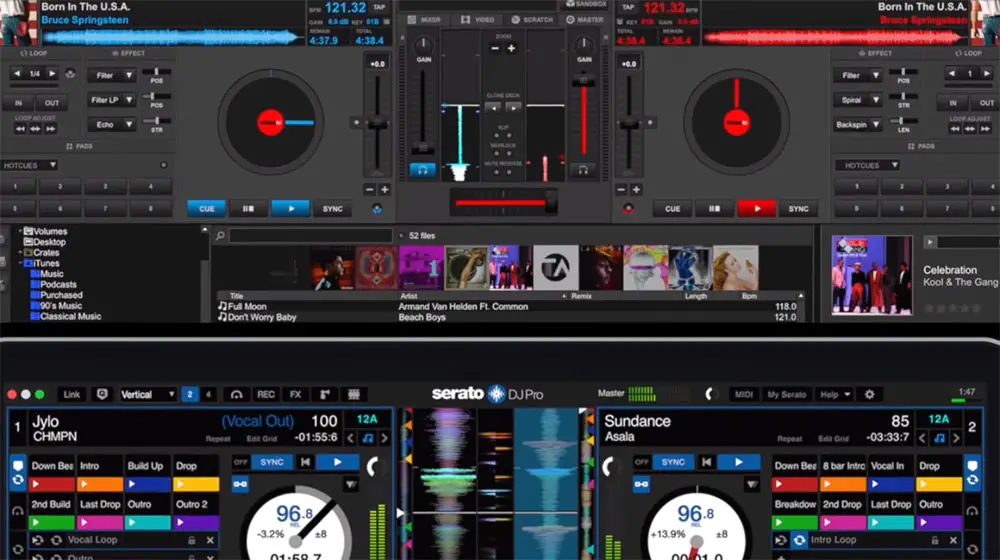Serato vs Virtual DJ – Which One to Pick?
Serato DJ and Virtual DJ have been pitching in the DJ software world since the very early days. Both have picked up a serious base of die-hard users. Both have transformed the way DJ software is made and the features they require. Both are still available for both standalone use and use with controllers. So, how do you split these industry stalwarts? It’s no easy task!
Overall, there is little real practical difference in what you can achieve on one or the other. Both are professional software platforms – Virtual DJ has long shaken the reputability of it being simply for the bedroom DJ. That being said, let’s compare them in key areas to see where each one excels and which one, if either, can be considered better or worse.
1. UI and UX
Serato DJ: Serato has a pro interface which is suited to the highest quality screens. It’s beautifully laid out and they’ve clearly put every effort into fine tuning it for top-level DJs and those which rely on it day-in-day-out. Serato DJ allows for 4 decks with full platter and waveform view. The library is well-organized with smart-crates and other nifty features that make life easier. In terms of stability, Serato DJ is rock-solid. It’s also 64-bit these days so will work with the very best laptops and computers. It’s a top class all round.
Virtual DJ: Virtual DJ maybe lacks that top-drawer crystal-clear interface BUT, it has an extremely customizable modular setup which can be altered with skins created by both Virtual DJ and their community. Some skins are designed to look exactly like a controller. This is awesome and it really sets Virtual DJ apart from any other software, not just Serato DJ. Also, Virtual DJ allows you to use up to 99 decks..yep 99! That sounds silly but you can load tracks onto a few decks and know they’re waiting for you in the mix. That means no navigation, you won’t even need to press a cue-point. Virtual DJ’s almost endless expandability can come at the price of stability, but for the most part, it’s rock-solid.
Summary: In essence, Serato DJ is well-tuned and ‘closed’. It’s been developed for professional DJs which rely on a setup which is well-tuned in its own right. It isn’t customizable but if it ain’t broke, don’t fix it. On the other hand, Virtual DJ disrupts the status-quo with its rather extreme levels of customization. This is awesome for pros and amateurs alike who are curious or desperate to try something different to the norm.

2. Hardware
Serato DJ: Serato DJ Lite comes bundled with a multitude of pro, semi-pro and budget level controllers. It’s totally free and though it’s limited in options compared to the full version, it does the job effectively and efficiently. Serato DJ is currently officially compatible with 53 controllers, tons of accessories including interfaces and CDJs and 17 mixers. That’s a lot of hardware BUT, it won’t work out-of-the-box with older controllers. However, it’s very easy to find mapping files online so this isn’t really a problem.
Virtual DJ: Virtual DJ has worked on providing its users near-universal compatibility. It works with almost anything and thanks to enormous community backing, you can find mappings for controllers of all sorts, past and present. By some estimation, Virtual DJ works on 300+ devices, tons of mixers, accessories, CDJs and almost any interface, which makes timecode use incredibly easy.
Summary: Virtual DJ is far more open. This makes it an awesome option for those who love tinkering with their equipment, or for beginners who want to just plug and play with a cheap controller. It gives the user the power to choose. Serato DJ, on the other hand, does work bundled with the popular Serato DJ Lite, which enables you to mix with the most important features.

3. Features
Serato DJ: Serato DJ is high-tech and fully-featured as it stands without even considering any additional packs. It has smart-crates, awesome chainable FX and excellent sampling modules for triggering sounds. However, its aftermarket packs is where it really springs to life. You have extra FX created by Izotope, Serato Flip, for remixing tracks with extra sample functionality, Pitch ‘n Time for seamless and precise pitch and time shifting (for warping keys, etc), Serato DVS and Serato Video. Obviously, buying all of these would cost a pretty penny but it provides almost endless opportunity for DJ creativity and development.
Streaming: Pulselocker is an online streaming platform for DJ software. It allows you to stream tunes straight to your decks. There’s a ton of choice as far as electronic music is concerned; house and techno, in particular, are provided by 40 labels.
Virtual DJ: Virtual DJ has community backing. That means more stuff for cheaper prices. Obviously the quality isn’t always up there but still, there are tons of quality options. Everything is well organized in Virtual DJ’s add-on section on the website. You can access video DJ add-ons, track edit software and lots of other weird and wonderful bits like user-made FX and performance pad layouts. Also, Virtual DJ allows for automixing which is great for function and party DJs. Lastly, Virtual DJ works very well on tablets and even smartphones.
Streaming: Pulselocker and Content Unlimited are the options for Virtual DJ. Pulselocker is the same as for Serato DJ but Content Unlimited is a little different and provides access to tons of music perfect for karaoke and functions.
Summary: Serato DJ comes with tons of aftermarket add-ons which really transform the software beyond its usual format. Yep, it can get expensive but honestly, you don’t need any extras if you don’t feel you need it. In fact, it’s perfectly fine to mix with just the free Serato Lite. However, for 4 decks and other features, Serato DJ Pro is the level choice. Virtual DJ, on the other hand, comes with tons of crazy add-ons accessible from its own add on center. There’s loads of stuff on there – go and take a look!

4. DVS compatibility
Serato DJ: Serato DJ was the original innovator in DVS technology and timecoding. They brought a wave of turntablists and scratchers to digital. Today, DVS isn’t quite as popular as it was but still, Serato DJ holds the aces in terms of the pro market. Most battle scratchers and similar use Serato setups. To run Serato DVS, you’ll need a compatible interface.
Virtual DJ: Virtual DJ is compatible with any interface. Manufacturers can disallow software from being compatible with interfaces they didn’t manufacture themselves but they can’t stop other software from working with them. This is a tremendous advantage for Virtual DJ.
Summary: Virtual DJ’s scratch engine is definitely competent at the highest levels. However, Serato DJ is an industry favourite for a reason and it’s a household name for scratchers and turntablists.
5. Licenses and pricing
Serato DJ: Serato DJ Lite is free. Serato DJ is $129 or $9.99 a month. Serato DJ essentials is an extra $11.99 a month and has add-ons including Serato Play (allowing for advanced use without hardware), Serato FX, Pitch ‘n Time and Serato Flip. The Serato DJ Suite contains pretty much everything for either $299 or $14.99 a month. Add-ons can also be bought permanently for around $39 to $99. It’d probably be best to buy the software and any add-ons individually without subscribing unless you want everything.
Virtual DJ: Virtual DJ Home is free but won’t work with hardware. Virtual DJ 8 Advanced Home is $49. The full pro suite is $299. Virtual DJ pricing does, however, vary depending on your controller, which can be a little confusing.
Summary: In the end, both are similarly priced. However, Serato is more transparent in its pricing. To be fair, it’d be rare you’d need everything, but for a fixed price of $299 for each, for life, it could be worse. Gone are the days where some software would set you back in the thousands.
The Verdict
Unsurprisingly, it’s hard to split Serato DJ and Virtual DJ. Serato DJ is typically viewed as one of the best DJ software platforms ever made and it’s widely viewed as the most popular choice right now for controller users at least, by a very thin margin perhaps, but a margin nonetheless. Serato DJ is highly dedicated and with bulletproof stability, tons of features and rock-solid functionality, it is hard to beat.
Virtual DJ, however, does bring a certain openness to the DJ software world. It’s easily used with almost any hardware, it’s easy to modify and customize and it may well work out as cheaper to use in the long run. Virtual DJ’s strongest hand is its community and add on center, which is full of awesome user-created content and well made official add-ons.
The best? Impossible to say! You may have a gut feeling – if you do, go for that. If not, then carefully assess your own DJ setup and choose the best software to satisfy your creative desires.
You may also like: